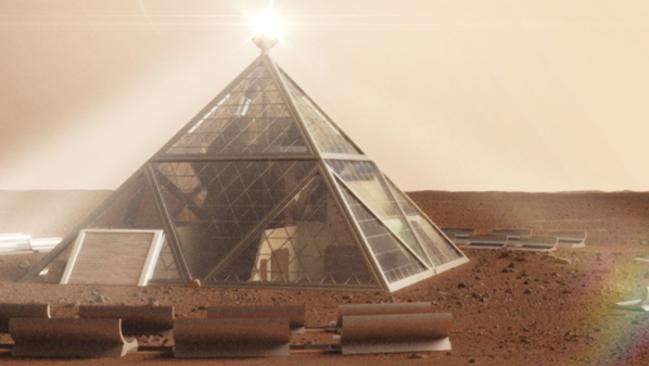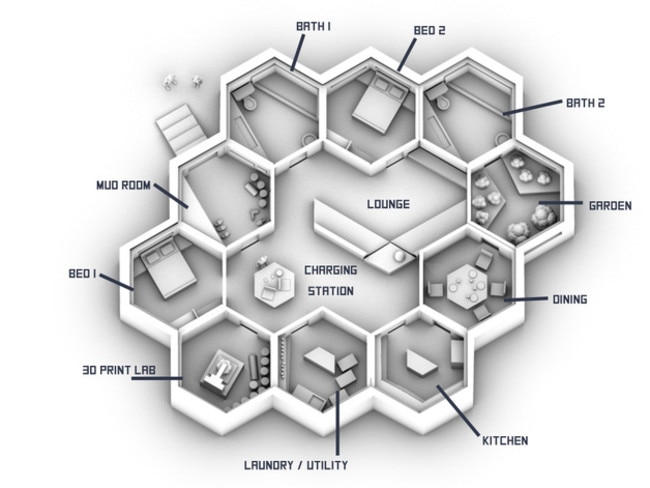NASA Mars base competition produces inspiring designs for life outside Earth
IT has killer dust storms, radiation and temperatures which plunge to -56C. And no air. To support life this is what a settlement on the Red Planet will look like.

PLANET Earth, we have a problem. NASA has asked the public to help with its most difficult challenge when it comes to colonising Mars — how to build a base. Here’s what life on the Red Planet could look like.
Killer dust storms. Radiation. Temperatures which plunge to -56C. And don’t forget there’s no air. These are just some of the issues which make a visit to Mars something less than a picnic.
Getting there is hard enough. Survival is just the next step.
And NASA needs inspiration.
An open challenge to the world’s creative thinkers posed the question: How would you build a Mars base capable of sustaining human life?
By the time the challenge closed in June, 224 entries had been submitted.
Now, the top three contenders for the Mars Base Challenge have been selected.
While the designs are obviously not made by engineers skilled in Mars’ local conditions, the creativity they contain will be used to help inspire NASA’s own team of experts as they methodically work towards their lofty goal.
Here’s a look at what the world’s problem solvers came up with:

MARTIAN PYRAMID
Some argue they’re already there. So, perhaps, this is more of a renovation job. But if no convenient (and empty) pyramids really reside on the face of Mars, why not bring your own?
The logic is infallible.
“The pyramid is one of the most iconic, long standing structures on Earth,” the entry reads. “Its stable triangular geometry has proven itself through the ages in ancient buildings around the world and its weather resistance in tent and teepee designs.”

The modular design emphasises the need for multi-functionality in order to conserve payload weights for delivery spaceships.
For example, the submission argues that mirror-based solar collector panels could provide necessary heating for the pyramid as a byproduct from their electricity generation. A small nuclear generator, however, would be needed to help get things up and running.
At the pyramid’s apex is the hydroponics system — also a beneficiary of the reflected sunlight of the mirrored arrays. Beneath is a labyrinth of rooms — heavily compartmentalised in case of atmospheric breach.

QUEEN B
Forget human inspiration. Go direct to nature. That’s the logic behind this modular plan which has won NASA’s attention.
A honeycomb of modular hexagons: Like a beehive, these standard shapes can be arranged, added to and modified on an ongoing basis.
It also makes transport simpler and puts assembly at Ikea alien-key competency levels.
Hexagons come with the added advantage of being particularly structurally sound. Interweaving clusters of such modules would provide added resistance to Mars’ frequent dust storms and their associated flying debris.

Capping the whole structure off is an interlaced roof structure of panels laminated with depleted uranium.
Why?
“With continuous exposure to cosmic radiation, any design that fails to fully attenuate cosmic radiation will put occupants at great risks for cancer and other health problems like Sasquatch feet or extra ears,” its creator writes.
The dense depleted uranium would be able to block most incoming cosmic rays.

MARS ACROPOLIS
Surely humankind’s first interplanetary outpost should make a statement? Where’s the thrill in modular, easy-assembled flatpack structures?
We’ve had decades of sci-fi based inspiration. Why not go the whole hog?
Such is the reasoning behind the Mars Acropolis.
“My design intent was to stray from the typical hexagonal pod design, and develop a creative blend of futuristic, yet modern stylisation,” the creator writes. “The design is not altogether farfetched, as proven scientific methods, and building materials, were followed and incorporated into my design.”

It’s inspiration is the iconic Greek Acropolis. But its form is also functional.
The three-tier structure would be built on a foundation of soil: A mix of both Earth and Mars loams to create an agricultural base to the structure.
An out wall of reinforced local-sourced concrete serves to deflect sand storms and attacking Martians
But at the Acropolis’ core are three substantial greenhouses. The creator cites sources which estimates a single mature tree can generate enough oxygen to support to humans.
Water for the trees can be condensed out of the Martian atmosphere, filling reservoirs above and below the structure.



